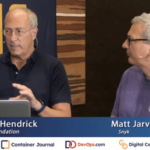
While open source software is ubiquitous and generally regarded as being secure, software development practices vary widely across projects regarding application development practices, protocols to respond to defects, or lack of standardized selection criteria to determine which software components are more likely to be secure. Consequently, software supply chains are vulnerable to attack, with implications and challenges for open source project communities.
To help improve the state of software supply chain security, the Linux Foundation, the Open Source Security Foundation (OpenSSF), Snyk, the Eclipse Foundation, CNCF, and CI/CD Foundation conducted research and released the findings in the report, Addressing Cybersecurity Challenges in Open Source Software, during the 2022 Open Source Summit North America.
At the Summit, Stephen Hendrick, LF’s Vice President of Research, and Matt Jarvis, Director of Developer Relations at Snyk, sat down with Alan Shimel of TechStrong TV to discuss the findings and next steps. Here are some key takeaways:
Alan: “ I think we’re always disappointed when we do the surveys that we find out, you know, beyond the lip service that gets paid to security, what actually is going on under the covers, and we’re always wishing for and hoping for more. That being said, I don’t want to be pessimistic. I am of the glass half full opinion that we are doing better and more security now than we probably ever have done.”
Stephen: “On the issue of, do organizations have an open source security policy. What we found was 49% said they had one, that’s good. 34% did not. And 17% said they don’t know.”
Matt: “In larger enterprises… you’ve got that kind of ingrained culture over a long time in terms of security and about how you consume software. . . the hardest problem in security isn’t really about technology at all. It’s always about people and culture. . . We’ve got two kinds of things happening in almost a perfect storm. At the same time, we’ve got this massive rise in supply chain attacks on open source, because, you know, it’s a victim of its own success. And attackers have realized it’s a lot easier to get into the supply chain than it is to find zero days in end user applications. So you’ve got that going on, where all of a sudden, folks are going, well, everything we do is based on open source, like, what do I do about security? And then, as Steve pointed out, you’ve got this, this ongoing, massive transformation of how we develop software, you know, this superfast high velocity.”
Stephen: “We asked. . . how do you intend to improve on the situation?. . . Top of the list was organizations are looking for more intelligent tools. . . That was at 59%. . . Right behind that at 52% was a strong desire to understand and essentially codify best practices for how to do secure software development”
Matt: “Culture change is such a big part of how you make that transition from your kind of old school, security as gatekeeper kind of function, to this thing, where we put it to the developers, because the developers are the ones who, you know, you fix it at the developer eyeball before it’s got anywhere near production. That is the cheapest.”
Stephen: “You know, I did a report last year on SBOMs. And I gotta tell you that factors right into this. . . we did some stats in this survey on dependencies, you know, both direct and transitive, and found, really, sort of low levels of strong, strong security around organizations understanding the security posture of all these different dependencies and dependencies of dependencies. Really low numbers there. SBOMs would go so far in helping sort all that out.
“They’re going to give you knowledge about the metadata, it’s gonna give you usability, so you know that you’re licensed to use the stuff, and it’s going to know if it was good, if you trust that not only what you’re looking at for metadata is not falsified, but also understanding quite clearly, you know, what’s been fixed, what hasn’t been fixed from a vulnerability standpoint.”
Matt: “I think when people think about policies, they think, Oh, this needs to be like a 100 page document of some kind, you know, then it becomes overwhelming, but really a policy can be a one liner.”
Watch the full interview and read the transcript below.
The post Hendrick and Jarvis Talk Software Security appeared first on Linux.com.


0 Commentaires